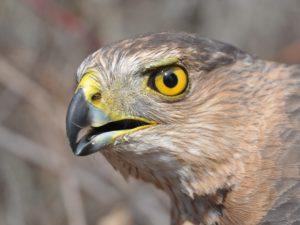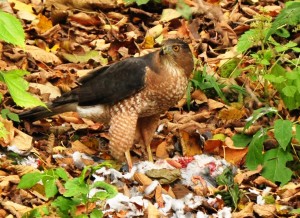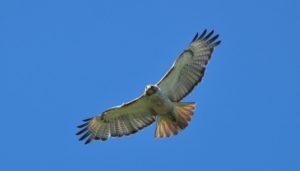Photography courtesy of Lowell Washburn, all rights reserved.
The annual fall migration of raptors — eagles, hawks, falcons, and ospreys — is one of Iowa’s most popular wildlife shows. Regardless of whether the habitats are grassland, forest, marsh, or open lake; there is no natural ecosystem that will not be visited by traveling birds of prey during the next several days.
Humans have long been intrigued with the speed and courage of our winged hunters. Unfortunately, fewer human admirers seem to appreciate, or even notice, the unique specializations of individual species – specializations that allow each bird to successfully occupy the niche it holds. It’s one of our best lessons in “avian diversity”.
Peregrine falcons, for example, are birds of the open skies. Equipped with long wings and short tails, these Top Gun speedsters make their living by out flying and capturing everything from shorebirds and teal to doves and pigeons.
By contrast, the woodland hawks [called accipiters] are characterized by pheasant-like short wings and long tails which allow greater maneuverability through extremely dense cover. Although three accipter species [the Cooper’s hawk, sharp-shinned hawk, and northern goshawk] may occur in Iowa during fall and winter, only the Cooper’s is a year round resident. Denizens of the deep forest, accipiters are known for short and explosive bursts of speed. All three species are savage and fearless hunters, and all are capable of easily taking prey exceeding their own body weight. During recent years, Cooper’s hawks have been learning to exploit urbanized landscapes where abundant populations of pigeons and starlings provide an easy meal.
Hunting tactics for the sturdily built red-tailed hawk are a bit more philosophical. Instead of relying on speed and dash, red-tails take a more patient approach as they lazily perch atop power poles or along the leeward edge of farm groves. Once prey is spotted – anything from mice to snakes to rabbits – the hawk calculates the situation and executes the attack.
Red-tailed hawks may also soar above open landscapes were they locate prey from great heights. Historically, soaring red-tails homed in on the billowing smoke of prairie fires where they capitalized on heat displaced, small mammals. In more recent times, red-tails have learned to apply the same principle as they follow the farmer’s combine to take advantage of fleeing rodents.
Bald eagles and ospreys are the only migrating raptors that depend on catching fish. A few seasons ago, I witnessed a rare event that may have made me the only Iowa falconer to ever eat a fish that was captured by an osprey. I was driving along Clear Lake’s South Shore Drive when a plump 19-inch channel catfish fell from the clear October sky and landed on pavement in front of my truck. Hitting the brakes, I jumped out of the vehicle and rushed to the still squirming fish. Turning my gaze upward, there was nothing but open blue sky. Picking up the fish, I immediately saw the deep talon punctures across its back. As near as I could determine, an osprey had just caught the fish and was coming off the lake to look for a dining perch. Another raptor, most likely a bald eagle, had attempted to rob the osprey [happens all the time] which culminated in the prize ending up on the yellow line of South Shore Drive. What isn’t speculation is the fact that we enjoyed a good laugh that evening as we savored our free catfish dinner.
LW






 Susan Judkins Josten
Susan Judkins Josten Rudi Roeslein
Rudi Roeslein Elyssa McFarland
Elyssa McFarland Mark Langgin
Mark Langgin Adam Janke
Adam Janke Joe Henry
Joe Henry Sue Wilkinson
Sue Wilkinson Tom Cope
Tom Cope Kristin Ashenbrenner
Kristin Ashenbrenner Joe Wilkinson
Joe Wilkinson Dr. Tammy Mildenstein
Dr. Tammy Mildenstein Sean McMahon
Sean McMahon